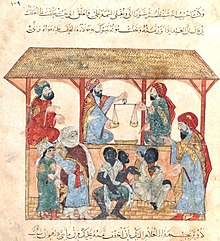Yahya ibn Mahmud al-Wasiti

Yahya ibn Mahmud al-Wasiti (Arabic: يحيى بن محمود الواسطي) was a 13th-century Iraqi-Arab[1][2][3] painter and calligrapher, noted for being the scribe and illustrator of al-Hariri's Maqamat dated 1237 CE (Bibliothèque Nationale de France, Arabe 5847).[4]
Biography
Al-Wasiti was probably born in Wasit, south of Baghdad.[5] In 1237 he transcribed and illustrated a copy of al-Hariri's Maqamat typically shortened to Maqamat, and also known as the Assemblies,[6] a series of anecdotes of social satire written by Al-Hariri of Basra. Al-Wasiti's illustrations, which are among the finest examples of a style used in the 13th-century, served as an inspiration for the modern Baghdad art movement in the 20th-century.[7]
Very little is known about his life. He was from the 13th century school of painting. He was known for his articulate painting style.[8]
Illustrations from Maqamat
In total, Maqmat has 96 illustrations, all by al-Wasiti. They are of "outstanding quality with fine composition, expressive figures, and vivid but controlled colours" and provide readers with "fascinating series of glimpses into and commentaries on 13th-century Islāmic life."[9]
See also
| Part of a series on |
| Arabic culture |
|---|
 |
References
- ^ Makiya, Kanan (1991). The Monument: Art, Vulgarity, and Responsibility in Iraq. University of California Press. p. 92. ISBN 9780520073760.
Arab painter al wasiti.
- ^ Ankori, Gannit (2013). Palestinian Art. Reaktion Books. ISBN 9781780232416.
- ^ Explorers: Tales of Endurance and Exploration. Penguin. 2010. ISBN 9780756675110.
- ^ Grabar, Oleg. The Illustrations of the Maqamat (PDF). University of Chicago Press. p. 10.
- ^ Jonathan Bloom and Sheila S. Blair (eds), Grove Encyclopedia of Islamic Art & Architecture, Oxford University Press, 2009, p.210; Kember, P. (ed.), Benezit Dictionary of Asian Artists, Oxford University Press, 2012, ISBN 9780199923014
- ^ Jonathan Bloom and Sheila S. Blair (eds), Grove Encyclopedia of Islamic Art & Architecture, Oxford University Press, 2009, p.294
- ^ Wijdan, A. (ed.), Contemporary Art From The Islamic World, p.166
- ^ "Yaḥyā ibn Maḥmūd al-Wāsiṭī," in: Encyclopædia Britannica, Online:
- ^ "Yaḥyā ibn Maḥmūd al-Wāsiṭī," in: Encyclopædia Britannica, Online:
- ^ a b Flood, Finbarr Barry (2017). "A Turk in the Dukhang? Comparative Perspectives on Elite Dress in Medieval Ladakh and the Caucasus". Interaction in the Himalayas and Central Asia. Austrian Academy of Science Press: 232.
- ^ Hillenbrand 2010, p. 126 and note 40.
- ^ Contadini 2012, p. 126–127: "Official" Turkish figures wear a standard combination of a sharbūsh, a three-quarters length robe, and boots. Arab figures, in contrast, have different headgear (usually a turban), a robe that is either full-length or, if three-quarters length, has baggy trousers below, and they usually wear flat shoes or (...) go barefoot (...) P.127: Reference has already been made to the combination of boots and sharbūsh as markers of official status (...) the combination is standard, even being reflected in thirteenth-century Coptic paintings, and serves to distinguish, in Grabar's formulation, the world of the Turkish ruler and that of the Arab. (...) The type worn by the official figures in the 1237 Maqāmāt, depicted, for example, on fol. 59r,67 consists of a gold cap surmounted by a little round top and with fur trimming creating a triangular area at the front which either shows the gold cap or is a separate plaque. A particular imposing example in this manuscript is the massive sharbūsh with much more fur than usual that is worn by the princely official on the right frontispiece on fol. 1v."
- ^ Hillenbrand 2010.
- ^ Contadini 2012, p. 143.
- ^ Shah 1980, p. 193.
Sources
- Contadini, Anna (1 January 2012). A World of Beasts: A Thirteenth-Century Illustrated Arabic Book on Animals (the Kitāb Na't al-Ḥayawān) in the Ibn Bakhtīshū' Tradition. Brill. doi:10.1163/9789004222656_005.
- Ettinghausen, Richard (1977). La Peinture arabe (in French). Geneva: Skira. pp. 104–124.
- Translated as Ettinghausen, Richard (1977b). Arab painting. New York : Rizzoli. ISBN 978-0-8478-0081-0.
- Grabar, Oleg (1984). The Illustrations of the Maqamat (PDF). University of Chicago Press. p. 7.
- Grabar, Oleg. "Maqamat Al-Hariri: Illustrated Arabic Manuscript from the 13th century". Retrieved 24 January 2023.
- Hillenbrand, Robert (1 January 2010). "The Schefer Ḥarīrī: A Study in Islamic Frontispiece Design". Arab Painting: 117–134. doi:10.1163/9789004236615_011. ISBN 978-90-04-23661-5.
- Shah, Amina (1980). The assemblies of al-Hariri : fifty encounters with the Shaykh Abu Zayd of Seruj. London : Octagon Press. ISBN 978-0-900860-86-7.
- Snelders, B. (2010). Identity and Christian-Muslim interaction : medieval art of the Syrian Orthodox from the Mosul area. Peeters, Leuven.
- Al Maqamat: Beautifully Illustrated Arabic Literary Tradition – 1001 Inventions

![Left frontispiece (1v): ruler in Turkic dress (long braids, Sharbush fur hat, boots, fitting coat), in the Maqamat of al-Hariri, 1237 CE, possibly Baghdad.[10][11][12]](https://upload.wikimedia.org/wikipedia/commons/thumb/4/4b/Ruler_in_Turkic_dress_%28long_braids%2C_fur_hat%2C_boots%2C_fitting_coat%29%2C_in_the_Maqamat_of_al-Hariri%2C_1237_CE%2C_probably_Baghdad.jpg/75px-Ruler_in_Turkic_dress_%28long_braids%2C_fur_hat%2C_boots%2C_fitting_coat%29%2C_in_the_Maqamat_of_al-Hariri%2C_1237_CE%2C_probably_Baghdad.jpg)
![Right frontispiece (2r): possible depiction of the author al-Hariri himself, in the Maqamat of al-Hariri, 1237 CE, possibly Baghdad.[10][13]](https://upload.wikimedia.org/wikipedia/commons/thumb/e/e6/Possible_depiction_of_al-Hariri%2C_in_the_Maqamat_of_al-Hariri%2C_1237_CE%2C_probably_Baghdad.jpg/76px-Possible_depiction_of_al-Hariri%2C_in_the_Maqamat_of_al-Hariri%2C_1237_CE%2C_probably_Baghdad.jpg)
![Maqama 10: Ayyubid Governor of Rahba, with Abū Zayd and his son.[14]](https://upload.wikimedia.org/wikipedia/commons/thumb/6/6d/Yahy%C3%A2_ibn_Mahm%C3%BBd_al-W%C3%A2sit%C3%AE_001.jpg/120px-Yahy%C3%A2_ibn_Mahm%C3%BBd_al-W%C3%A2sit%C3%AE_001.jpg)
![Maqama 39: the Queen of Oman giving birth.[15]](https://upload.wikimedia.org/wikipedia/commons/thumb/a/a0/Yahy%C3%A2_ibn_Mahm%C3%BBd_al-W%C3%A2sit%C3%AE_003.jpg/95px-Yahy%C3%A2_ibn_Mahm%C3%BBd_al-W%C3%A2sit%C3%AE_003.jpg)







